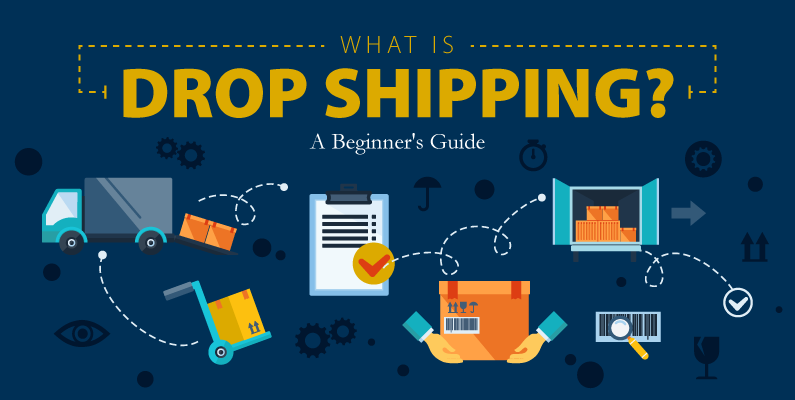What is dropshipping How does it work in 2024? Dropshipping is a fulfillment model that allows entrepreneurs to outsource handling and shipping products to a third party. This fulfillment method can appeal to entrepreneurs seeking efficiency and low overhead, but it has trade-offs.

What is dropshipping?
Dropshipping is an order fulfillment option that allows ecommerce businesses to outsource the processes of procuring, storing, and shipping products to a third party—typically a supplier.
This fulfillment model commonly appeals to entrepreneurs seeking efficiency and low overhead, but it can come at a cost—especially when it comes to customer experience. This guide will cover what drop shipping is and explore how this fulfillment method can work. We’ll also look at a few dropshipping alternatives that can potentially save you time, lower your overhead, or simplify your business.
What is a dropshipping business model?
In a dropshipping business model, you promote products and provide an online storefront. When a customer places an order, you send the order to the drop shipper and inform customers the products are on the way.
The rest of the physical fulfillment process is out of your hands. In some dropshipping agreements, you may also handle customer service while the dropshipping service manages the physical goods and fulfillment.
How does dropshipping work?
The exact logistics of dropshipping depend on your arrangement, but typically the dropshipping process follows this general sequence:
- Seller signs agreement with drop shipper.
- Customers order online.
- The seller receives the order.
- The customer receives an order confirmation.
- The seller forwards the order to Dropshipper.
- The drop shipper ships the order.
- A customer receives their product.
Key players in the dropshipping model
Let’s unpack some of the key players and their roles in detail, starting with the seller of record—in other words, your business. dropshipping it work in 2024?
Seller of record
The dropshipping process starts with you. As the seller of record (SoR), you’re the individual identified as selling the product to the end consumer. You set the price, record the purchase as revenue, and assume responsibility for the sales tax on a particular sale. Even when a third party stocks and ships the items, you’re the seller of record because you own the products before they ship to the customer.
For Amazon sellers, using a dropshipping service is generally allowed by Amazon’s dropshipping policy, as long as you’re the seller of record and identify yourself as such. dropshipping it work in 2024?
Manufacturers
Manufacturers make products to sell to wholesalers and retailers. You can purchase goods from manufacturers, but the bulk purchase amounts they may require can potentially be a barrier to starting or scaling your business. Some manufacturers may offer dropshipping services. dropshipping it work in 2024?
Wholesalers
In a typical product supply chain, wholesalers buy from manufacturers and sell to retailers at a slight markup. They function as middlemen; generally, they do not sell to the end consumers but may provide drop shipping services to retailers.
Determine which dropshipping providers could be right for you based on your business model and fulfillment requirements, among other factors.
Potential pros and cons of dropshipping
In ecommerce, as in life, there are advantages and disadvantages to any fulfillment approach. Whether the gains are worth the pain largely depends on your goals and business situation. Here are potential pros and cons to consider when weighing whether dropshipping is right for your business.
Possible benefits of dropshipping include:
- Overhead costs: Since you don’t store or ship the products, dropshipping has the potential to lower overhead costs, such as maintaining a storage facility or sending products to customers.
- Starting costs: Entrepreneurs looking to start a business with minimal investment may turn to dropship as they don’t need to invest in facilities or resources to process orders.
- Reduced risk: Since you don’t have to pay for inventory, there’s less risk of losing money due to lost merchandise or over-ordering products.
- Multi-channel selling: You can use drop shipping for your business while selling on your own domain, through a store like Amazon, or through social media channels —or all of the above.
- Operating location: Dropshipping allows you to fulfill orders regardless of your operating location, opening up the possibility to work from anywhere.
- Scalability: Leveraging suppliers can make it feasible to accept more orders without increasing the inventory you store, package, and ship.
- Wide variety of products: Depending on your agreement, there may be no need to pre-purchase inventory, so you can sell a broad range of items and increase your earning potential.
- Flexibility: Not sure what goods to sell? Dropshipping allows you to test different goods to see what sells best without worrying about losing your investment.
Potential limitations for dropshipping include:
- Competition: Given the low cost and investment to get started, dropshipping is a highly competitive field.
- Product quality: Dropshipping reduces your involvement in the order fulfillment process, curtailing your ability to monitor and guarantee product quality.
- Branding: Because the products you sell may not be unique or distinguishable from similar offerings by other sellers, you could have trouble differentiating your offering.
- Profit margins: Little to no product differentiators means your business may end up competing more aggressively on price. Selling at low prices can eat up your profit margin.
- Fulfillment timeline: When a dropshipping service handles the fulfillment process, you do not have control over order selection, packaging, and shipment.
- Inventory management: Up-to-the-minute updates on what is available in stock may not be possible. If a customer places an order only to find the product is out of stock, this poor experience can discourage future orders and damage your brand.
- Range of offers: Because you don’t handle order fulfillment, you may be limited in the special offers and promotions you can run, such as bundling or free shipping.
- Supplier errors: Low-quality drop shippers may make mistakes when fulfilling customer orders. This could lead to botched orders, low-end packing, and missing items.
- Complex customer service: With drop shipping, you’re still responsible for your reputation and keeping customers happy. If things go wrong with the fulfillment process, managing customer support might be up to you.
For some businesses, dropshipping limitations do not outweigh the potential benefits. Luckily, if you want to lower your inventory management and order fulfillment costs, a service like Fulfillment by Amazon may be an option. For some sellers, FBA provides a happy medium, offering many of the benefits of dropshipping without the downsides. dropshipping it work in 2024?
Is dropshipping right for you?
It depends on your business. Here are a few questions to ask yourself if you’re considering dropshipping.
How do you want to build your brand?
Your brand is the look and feel of customer-facing aspects of your business. Building a memorable brand impression can help grow customer loyalty.
While you may be able to create a branded online experience, dropshipping gives you less control over product quality, delivery experience, and the aesthetics of the final package. If the products and packaging fall short of expectations, a customer may choose not to purchase from your brand again.
Dropshipping suppliers often offer little room for product customization. This limitation may make it difficult to set your brand apart from the competition.
How much control do you want over product quality?
Product quality can have a big impact on other aspects of your business such as customer acquisition, brand loyalty, and returns. While you may be able to inspect the quality of products at the start of your dropshipping relationship, you will likely have limited control over the quality of the items you sell on an ongoing basis.
If the products fail to meet customer expectations, your business could receive negative customer reviews.

How quickly do you want to ship products?
Ecommerce customers tend to expect quick shipping. In a recent survey, nearly 84% of people surveyed regarded delivery as an essential part of their online shopping experience.
Long shipping times can negatively impact your business. When working with a dropshipping supplier, review its standard shipping costs and delivery timeframes.
For sellers looking for fast order fulfillment services, a service like FBA can be valuable.
This fulfillment method can appeal to entrepreneurs seeking efficiency and low overhead, but it has trade-offs.

Hello friends, my name is Shivam Kumar, and I am a writer, skilled in creating engaging, SEO-optimized content on online income and content creation since last two years. And I will be sharing this information form my blog.
1 thought on “What is dropshipping? How does it work in 2024?”